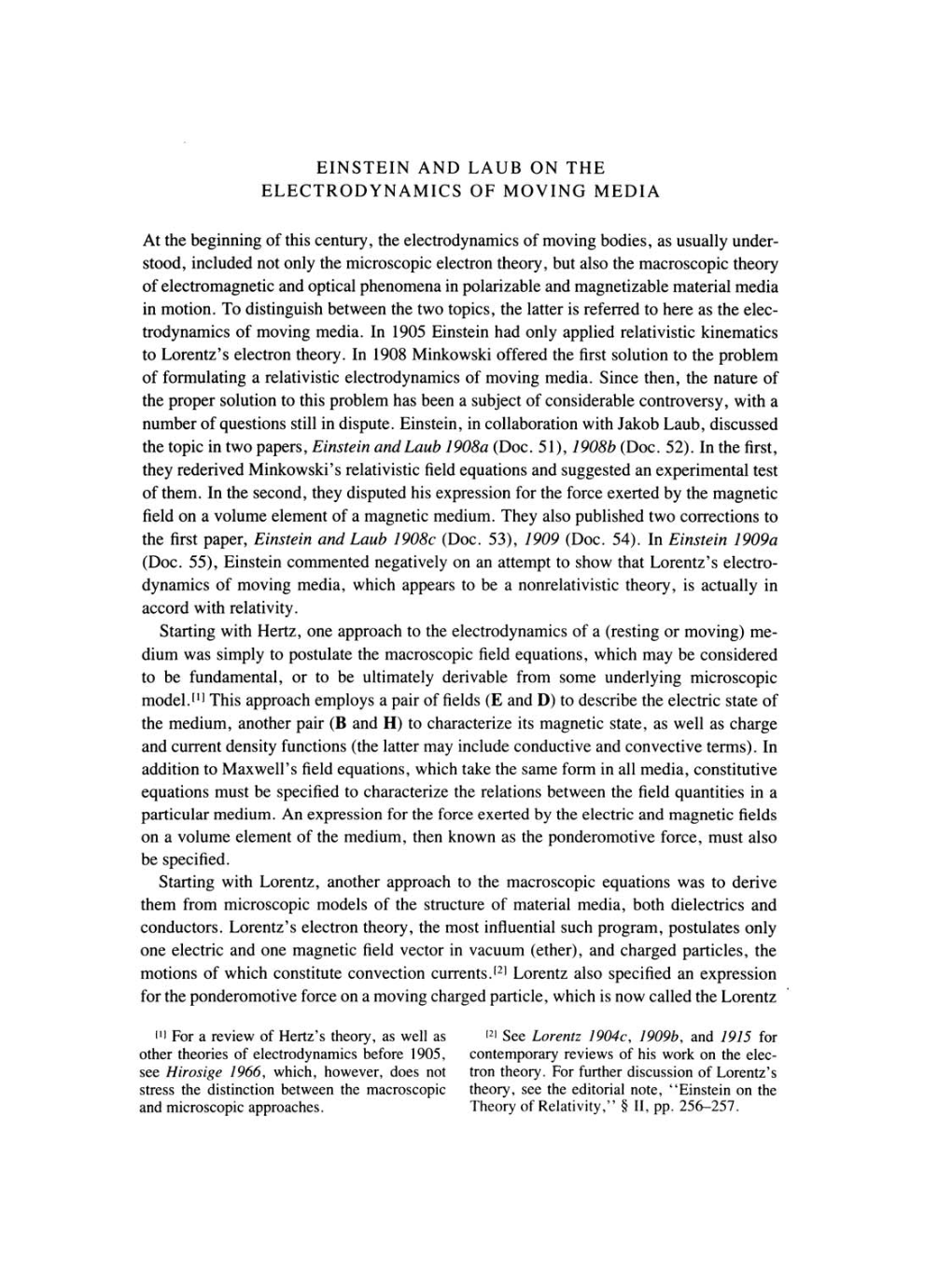EINSTEIN AND LAUB ON THE
ELECTRODYNAMICS
OF MOVING MEDIA
At the
beginning
of
this
century,
the
electrodynamics
of
moving
bodies,
as
usually
under-
stood,
included not
only
the
microscopic
electron
theory,
but also the
macroscopic theory
of
electromagnetic
and
optical phenomena
in
polarizable
and
magnetizable
material
media
in
motion. To
distinguish
between the two
topics,
the latter
is
referred to here
as
the
elec-
trodynamics
of
moving
media. In
1905
Einstein had
only applied
relativistic kinematics
to
Lorentz's
electron
theory.
In 1908 Minkowski offered the first solution
to
the
problem
of
formulating a
relativistic
electrodynamics
of
moving
media. Since
then,
the nature
of
the
proper
solution
to
this
problem
has been
a subject
of
considerable
controversy,
with
a
number
of
questions
still in
dispute.
Einstein, in
collaboration with Jakob
Laub,
discussed
the
topic
in two
papers,
Einstein
and
Laub 1908a
(Doc. 51),
1908b
(Doc. 52).
In the
first,
they
rederived
Minkowski's
relativistic field
equations
and
suggested an experimental
test
of
them. In the
second,
they disputed
his
expression
for the force exerted
by
the
magnetic
field
on a
volume element
of
a magnetic
medium.
They
also
published
two
corrections to
the
first
paper,
Einstein
and Laub
1908c
(Doc. 53),
1909
(Doc. 54).
In
Einstein
1909a
(Doc. 55),
Einstein commented
negatively
on an
attempt
to
show
that
Lorentz's
electro-
dynamics
of
moving media,
which
appears
to
be
a
nonrelativistic theory,
is
actually
in
accord
with
relativity.
Starting
with
Hertz, one
approach
to
the
electrodynamics
of
a (resting or moving) me-
dium
was simply
to
postulate
the
macroscopic
field
equations,
which
may
be
considered
to be
fundamental,
or
to be
ultimately
derivable from
some underlying
microscopic
model.[1] This
approach employs a pair
of
fields
(E
and
D) to
describe the electric state
of
the
medium,
another
pair
(B
and
H) to
characterize its
magnetic
state,
as
well
as charge
and current
density
functions
(the
latter
may
include conductive and convective
terms).
In
addition
to
Maxwell's
field
equations,
which take the
same
form
in
all
media,
constitutive
equations
must
be
specified
to characterize the relations between the field
quantities
in
a
particular
medium. An
expression
for the force exerted
by
the electric and
magnetic
fields
on a
volume element
of
the
medium,
then known
as
the
ponderomotive
force, must
also
be
specified.
Starting
with
Lorentz,
another
approach
to
the
macroscopic equations was
to
derive
them from
microscopic
models
of
the structure
of
material
media,
both dielectrics and
conductors.
Lorentz's
electron
theory,
the
most
influential such
program, postulates only
one
electric and
one magnetic
field vector
in
vacuum (ether),
and
charged
particles,
the
motions
of
which constitute convection currents.[2] Lorentz
also
specified an expression
for the
ponderomotive
force
on
a
moving charged particle,
which
is
now
called the Lorentz
[1]
For
a
review
of Hertz's
theory, as
well
as
other theories
of
electrodynamics
before
1905,
see
Hirosige 1966, which, however,
does
not
stress
the distinction between the
macroscopic
and
microscopic approaches.
[2]
See Lorentz
1904c, 1909b,
and 1915 for
contemporary
reviews of his work
on
the elec-
tron
theory.
For further discussion
of
Lorentz's
theory, see
the editorial
note,
"Einstein
on
the
Theory
of
Relativity,"
§
II,
pp.
256-257.
